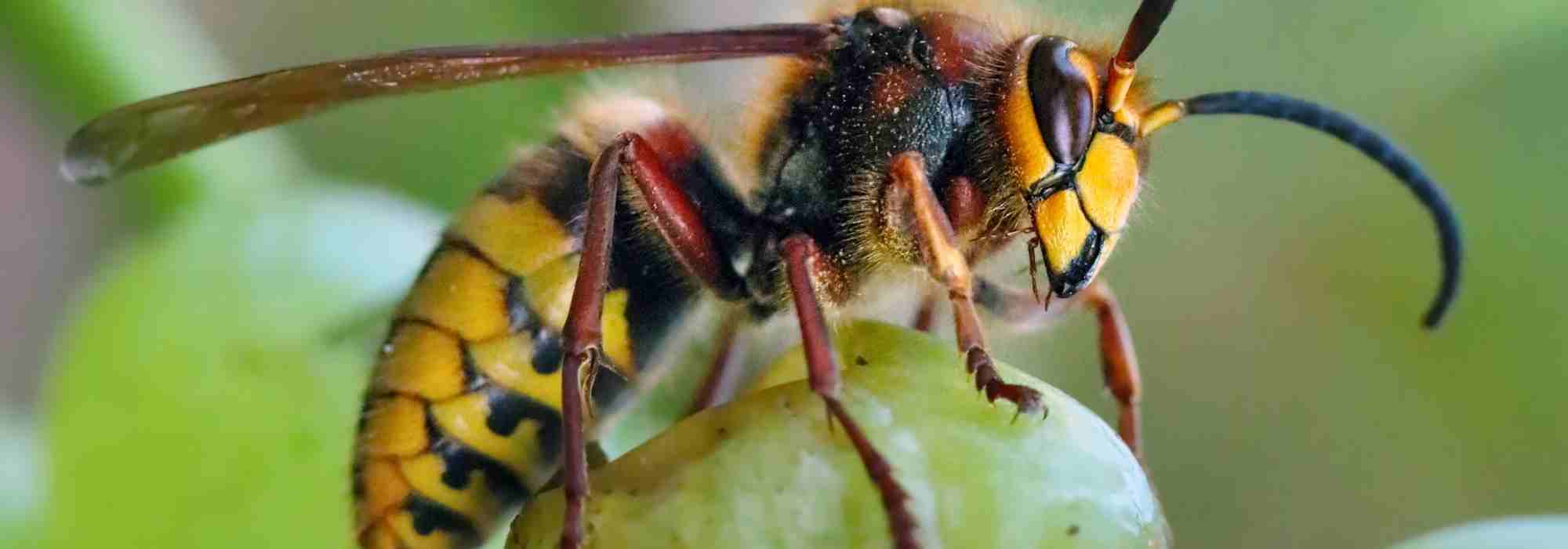
How to protect your fruit harvest from hornets?
Our tips for effectively controlling hornets that feast on fruits at peak ripeness
Contents
As every year, the branches of your plum tree bend under the weight of fruit. The harvest looks promising, and already, you’re salivating at the thought of tasting these perfectly juicy and sweet fruits. Except that hornets have set their sights on these sun-ripened plums, from which they extract the juice to feed their larvae. Beyond the danger posed by the presence of these hornets, whether European or Asian, in your trees – which will sting if they feel threatened – your fruit harvest risks being severely compromised. An attacked fruit is a spoiled fruit that may rot on the tree. And hornets target many fruits, from plums to pears, including peaches, apricots, apples, grapes…
Discover the various natural solutions to deter or trap the hornets that swarm your ripe fruits every summer.
Understanding the life cycle of hornets to better control them
For several years now, our gardens and orchards have been regularly visited by two species of hornets, hymenopteran insects classified as social wasps: the European hornet (Vespa crabro), present in our country for hundreds of years, and the yellow-legged Asian hornet (Vespa velutina nigrothorax), an invasive species, which arrived in France in 2015 and is now present across almost the entire territory.
Two hornets differing in appearance
These two species of hornets are primarily distinguished by their appearance. The Asian hornet is slightly smaller, with a darker, almost brown body, featuring just one orange-yellow segment and brown legs with yellow tips. The European hornet resembles a large wasp.
Another distinguishing feature is their diet. While both types of hornets attack ripe fruit, they also play a predatory role. The European hornet captures various insects such as flies, butterflies, caterpillars, and grasshoppers, whereas the Asian hornet targets honeybees and even solitary bees. However, the most concerning impact is on beehives and honey production, posing a significant problem for beekeepers. Efforts to control them are underway, but the Asian hornet remains a severe threat, especially considering that honeybees are already heavily affected by pesticidal use in agriculture.
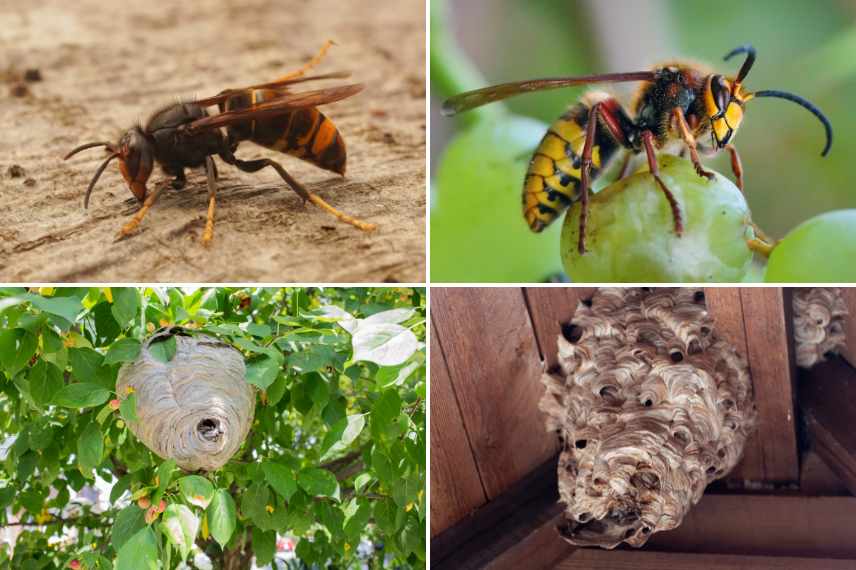
On the left, the Asian hornet and its nest; on the right, the European hornet and its nest
A fairly similar life cycle
In spring, the future founding queens of the colony, fertilised the previous autumn, emerge from diapause to create a nest. They lay the first eggs, which will develop into worker hornets responsible for tending to the larvae and maintaining the nest. By late summer, male reproductors emerge, fertilising the future queens before dying. In autumn, the entire colony dies off, except for the future queens.
The European hornet builds its nest in cavities (hollow trees, walls, attics…), while the Asian hornet constructs its nest in trees.
Read also
A Wasp Nest in Your Garden: What to Do?Why do hornets attack fruits at ripeness?
The native European hornet feeds on insects, ripe fruit and sweet substances, but remains relatively discreet in orchards. However, it can pierce the skins of juicy fruits like plums, pears, apples, grapes, particularly in late summer, when the colony reaches maturity. Its impact on harvests often remains moderate.
The Asian hornet is more opportunistic. It attacks ripe fruit with great efficiency, especially when there are no longer enough insects to feed the colony. This species is also more active in flight and more resistant to variable weather conditions, which extends its period of nuisance in the orchard.
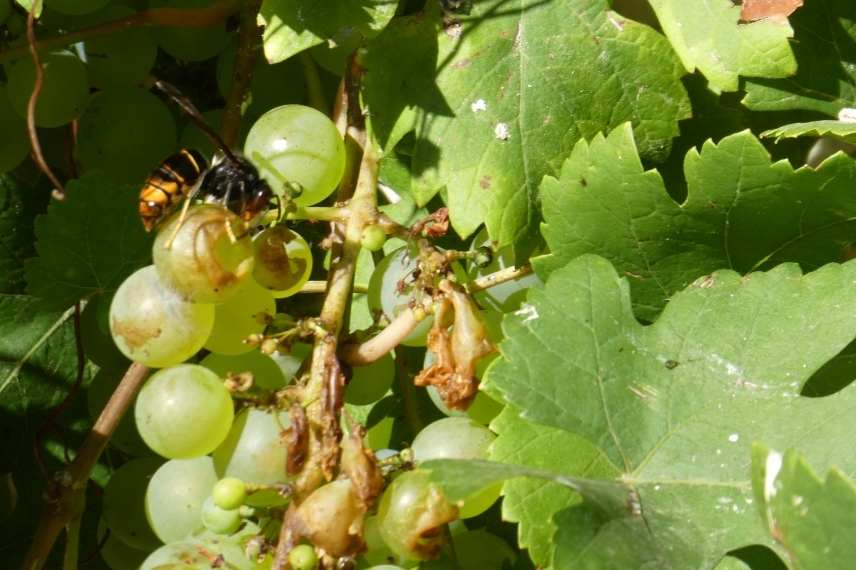
Hornets harvest fruit sugar to feed their larvae
Attacks usually occur between July and October, when colonies reach peak numbers and sugar demands soar. Hornets are attracted to fully ripe fruit, mostly those with thin skins and high juice content. They cut into them to access the pulp, causing wounds that invite rot and secondary insects. Within hours, an entire tree can be visited by dozens of individuals.
Contrary to popular belief, hornets do not target fruit randomly. Their behaviour is guided by very specific olfactory cues: fermentation of fallen fruit on the soil, juice oozing from cracks, exposed sugar after bird pecking or thin damage. A single successful visit is enough for them to memorise the location and return regularly, sometimes in groups. This is why it is essential to collect fallen or spoiled fruit from trees very regularly. This is the first method to prevent hornets from swarming your ripe fruit.
The most effective methods to keep wasps away from fruit
If you already see a few hornets flying around your fruit trees, or if you simply want to anticipate attacks, several methods can be implemented, more or less simple to install.
Installing very fine insect-proof netting
Fine-mesh insect nets, often used to combat birds or codling moths and other fruit tree pests, can prove very effective against hornets. These nets, made from polyethylene and finely woven, create a physical barrier that effectively protects the fruit without preventing them from continuing to ripen.
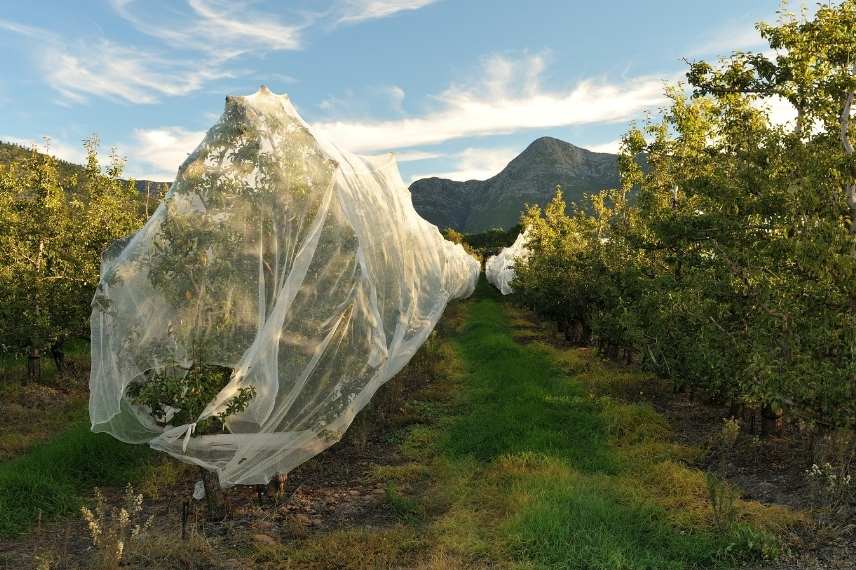
Insect-proof netting
While insect-proof netting is effective, it can be tricky to install, especially on large fruit trees. However, it is entirely feasible with two people and long poles to drape the netting over the branches. It should then be secured to the trunk with string.
If fruit harvesting is staggered, simply loosen the netting at the bottom and reach underneath for picking.
Bagging fruit: an effective but time-consuming solution
In late summer, bagging fruit such as pears, apples, peaches, and grapes is a highly effective technique to protect nearly ripe fruit from hornet attacks. However, this method is very time-consuming and requires patience and meticulousness. Each fruit must be individually bagged, protecting them not only from hornets but also from codling moths, hail, and even certain fungal diseases like scab or brown rot.
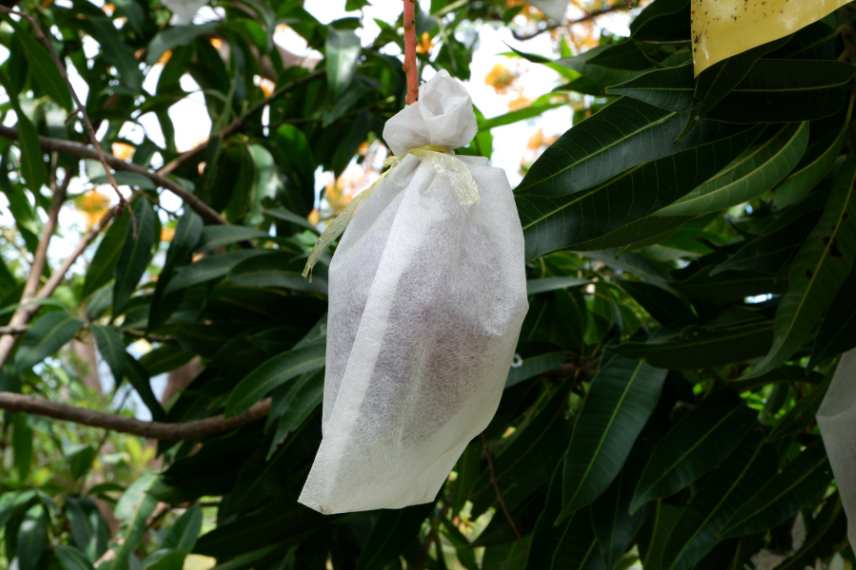
The principle of fruit bagging
Traditionally, amateur orchardists used kraft bags—practical and economical but not rain-resistant and too thick to let light through. Today, very fine mesh bags, either tie-on or zip-up, are available to enclose apples, pears, and grape clusters. If you want to protect your fruit from hornets, these bags can be applied before ripening begins. Installing them in early summer also safeguards against other pests.
Setting up hornet traps
Commercial traps vary in effectiveness, but it’s relatively simple to make your own hornet traps. For the method to be truly effective, the lure must be more attractive than ripe fruit, and traps should be placed both in trees and on the ground.
Discover the instructions for making a hornet trap, written by Virginie D.: Asian hornet trap: how to make one?
A simpler trap can be made using a plastic bottle with two small 8mm entry holes cut near the top. The cut section is folded upwards to prevent rain from entering. This type of trap allows smaller trapped insects to escape.
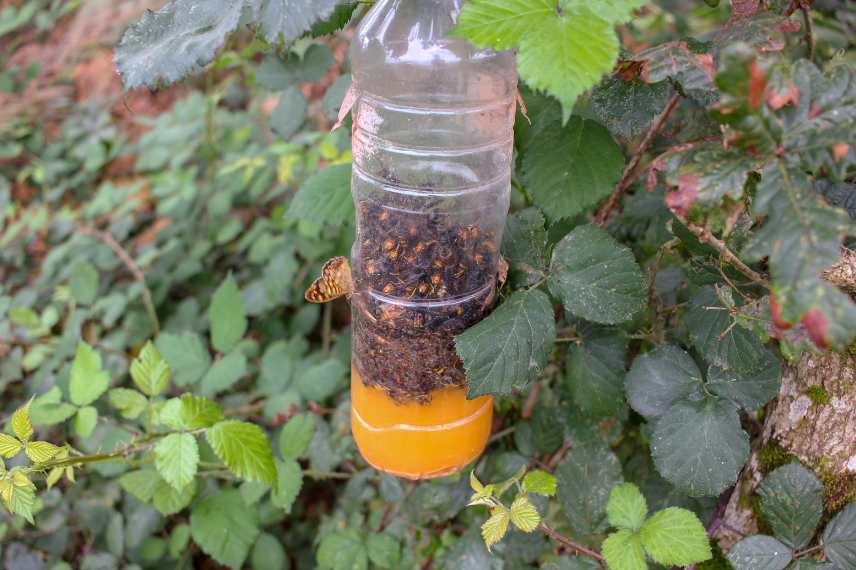
This type of trap with side entry holes is quite effective against hornets.
In these bottles, pour sweet mixtures that attract hornets, such as apple juice or blackcurrant juice mixed with beer (two parts juice to one part beer). A little honey or jam around the entry holes enhances the lure. The bottle is then hung in the trees.
What if the hornet attack is massive?
A massive hornet attack on your fruit should not be taken lightly, as it may indicate a nearby nest. In this case, the stakes go beyond just protecting the fruit and also concern the gardener’s safety and the balance of the ecosystem.
The first step is to locate the nest, which can be tricky. The Asian hornet often builds its secondary nests high up, in large trees, dense hedges or under the roofs of seldom-used buildings. Its fast, direct flight sometimes allows you to spot a regular back-and-forth between the orchard and a wooded or built-up area: this is a good clue to start searching.
When a nest is identified close to a pathway or a family garden, it is essential to call in a specialised company certified Certibiocide for its removal. Attempting removal without proper equipment or training poses a real danger, as hornets become aggressive near their nest.
If the nest cannot be located or destroyed, intensifying trapping can be a temporary solution.
In several French departments, the Asian hornet is subject to coordinated control efforts by local authorities, agricultural unions and the DRAAF (Regional Directorate for Food, Agriculture and Forestry). Control measures may be implemented. Simply contact your local town hall for assistance.
- Subscribe!
- Contents































Comments